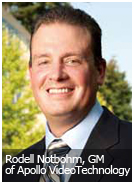Maintaining public transit security usually falls to the system integrator who installed the system. “It is the responsibility of the system integrator to ensure the complete integration together with the customer approving it,” Anderson said. “Typically several pilot tests are made and finally an acceptance test and sign-off in these kinds of larger surveillance system projects.”
Technical Assistance
Maintaining public transit security usually falls to the system integrator who installed the system. “It is the responsibility of the system integrator to ensure the complete integration together with the customer approving it,” Anderson said. “Typically several pilot tests are made and finally an acceptance test and sign-off in these kinds of larger surveillance system projects.”
The integrator has to be on-call for mishaps such as failing cameras to full-blown crises. While the transit authority will have its own security force, equipment issues are generally handled by the installer. With such a range of situations, integrators need to have good communication skills for problems and challenges, Segall said
Experience is a definite plus. “VidSys looks for integrators with physical security and IT industry expertise and demonstrated client engagements across vertical markets, a particular technology or industry niche,” Fowler said.
Public-transit work is carried out by reliable system integrators, who are either global or local. “Through this cooperation we can guarantee the supply of reliable and high-quality ticket and card materials for mass transit systems and be certain that they operate in the system without interruptions,” said Samuli Str?mberg, VP of Marketing, RFID, UPM Raflatac.
While having a long resume helps, it must reflect positively on the integrator. The U.S. is UTC Fire & Security's main market for public transit, which is large but tight-knit. “The properties know what the other properties are doing,” Szmania said. “They hear the good things and the bad things about the systems. Your reputation is extremely important to your business.”
Specifying Security
 As any number of things could disrupt mass transit, careful planning is a prerequisite. “Typically, the mass transit system, integrator and Infinova work together on the design of the system to ensure that the resulting solution meets the mass transit organization's expectations,” Wilson said.
As any number of things could disrupt mass transit, careful planning is a prerequisite. “Typically, the mass transit system, integrator and Infinova work together on the design of the system to ensure that the resulting solution meets the mass transit organization's expectations,” Wilson said.
Newer technologies are seeing uptake, albeit slowly. Agent Vi has seen more requests for proposals specify analytics and has generated awareness by publishing case studies. “Offering case studies allows systems integrators and end users alike to read about our solutions and determine whether they are suitable for their needs,” Ashani said. “It's not a cutting-edge market; integrators and end users want to see results before they try it themselves.”
Most vendors certify installers or contractors on how to deploy their solutions in a timely fashion. “The sales cycle is pretty long and the project size is quite large, so it is normal to have more parties involved,” said Cosimo Malesci, VP of Channel Sales and Marketing, Fluidmesh Networks.
Because of the long sales cycle, as well as the extended product life span, scalability is a procurement consideration. “Purchasing a system with upward compatibility is important from the outset because it enables transit agencies to upgrade and enhance a system without having to purchase brand new equipment,” Notbohm said. “Transit agencies should also investigate the vendor's product road map to ensure they can equip additional vehicles that are compatible with the rest of the fleet, as budgets allow.”
Today security is factoring into station design long before they are built. “Security needs to have the infrastructure is in place to support it,” said Jamie Edgar, Global Director of Integrated Sensor Systems, Smiths Detection. “For metros built 20 years ago, it's costly to go in and provide retrofitted solutions. There's usually not enough space.”